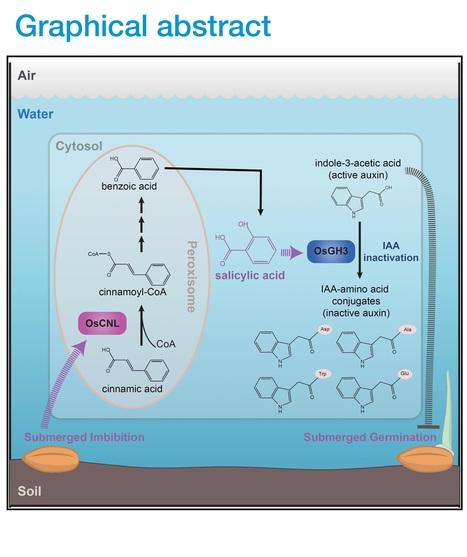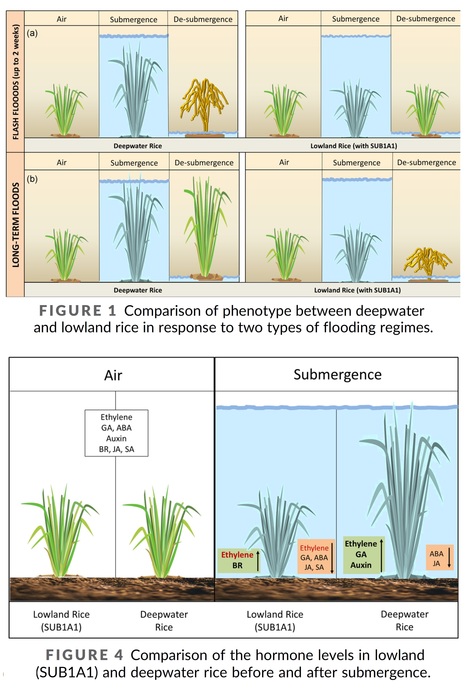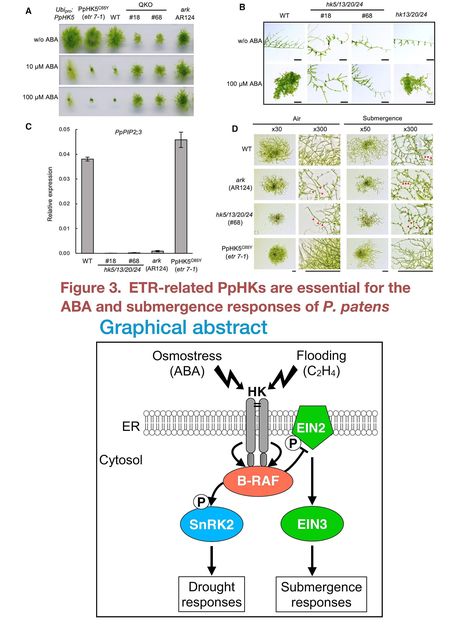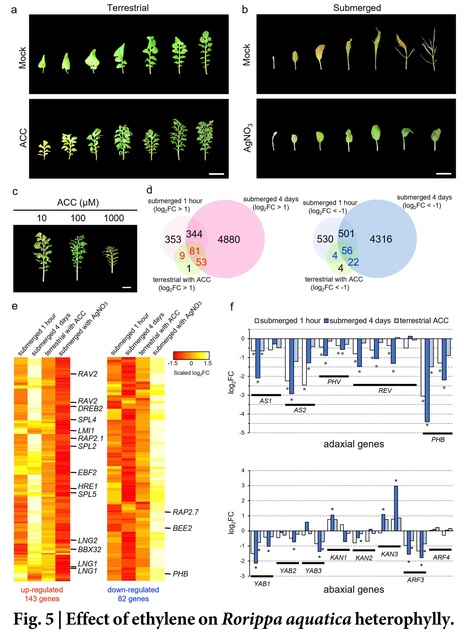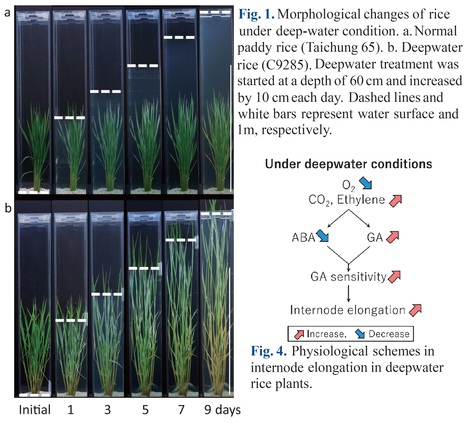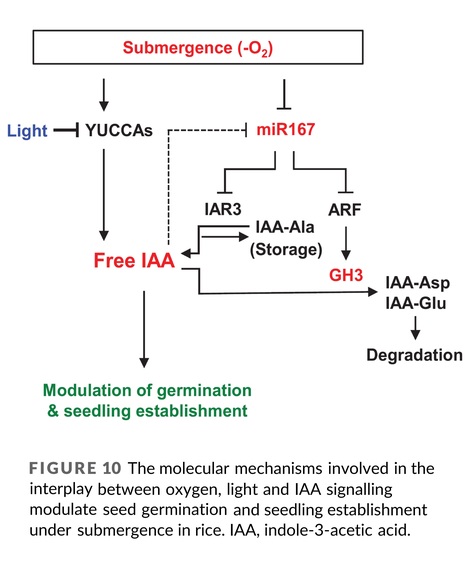 Your new post is loading...
 Your new post is loading...
Authors: Sahana Basu, Monika, Surbhi Kumari and Gautam Kumar.
Plant Physiology and Biochemistry (2024)
Highlights: • IAA induces lateral root formation in rice under submergence • ROS and RNS cause lysigenous aerenchyma formation in root cortex of rice • Submergence decreases ABA level, causing GA-mediated escape response in rice shoot • Enhanced antioxidant levels dampen nitro-oxidative damage during de-submergence
Abstract: "Constant change in global climate has become the most important limiting factor to crop productivity. Asymmetrical precipitations are causing recurrent flood events around the world. Submergence is one of the most detrimental abiotic stresses for sustainable rice production in the rainfed ecosystems of Southeast Asia. Therefore, the development of submergence-tolerant rice is an essential requirement to encounter food security. Submergence tolerance in rice is governed by the major quantitative trait locus (QTL) designated as Submergence1 (Sub1) near the centromere of chromosome 9. The introduction of the Sub1 in high-yielding rice varieties producing near-isogenic lines (NILs) has shown extreme submergence tolerance. The present study aimed to understand the responses of rice genotype IR64 and its Sub1 NIL IR64 Sub1 following one week of complete submergence treatment. Submergence imposed severe nitro-oxidative stress in both the rice genotypes, consequently disrupting the cellular redox homeostasis. In this study, IR64 exhibited higher NADPH oxidase activity accompanied by increased reactive oxygen species, reactive nitrogen species, and malondialdehyde buildups and cell death under submergence. Higher accumulations of 1-Aminocyclopropane-1-carboxylic acid, gibberellic acid, and Indole-3-acetic acid were also observed in IR64 which accelerated the plant growth and root cortical aerenchyma development following submergence. In contrast, IR64 Sub1 had enhanced submergence tolerance associated with an improved antioxidant defense system with sustainable morpho-physiological activities and restricted root aerenchyma formation. The comprehensive analyses of the responses of rice genotypes with contrasting submergence tolerance may demonstrate the intricacies of rice under complete submergence and may potentially contribute to improving stress resilience by advancing our understanding of the mechanisms of submergence tolerance in rice."
Authors: Yukang Wang, Gaochen Jin, Shuyan Song, Yijun Jin, Xiaowen Wang, Shuaiqi Yang, Xingxing Shen, Yinbo Gan, Yuexing Wang, Ran Li, Jian-Xiang Liu, Jianping Hu and Ronghui Pan.
Developmental Cell (2024)
Editor's view: Wang et al. demonstrated a peroxisomal cinnamate:CoA ligase (CNL)-dependent phytohormone metabolic cascade in rice. Submerged imbibition-induced salicylic acid (SA) biosynthesis promotes anaerobic germination by inducing OsGH3-mediated indole-acetic acid (IAA)-amino acid conjugation, thus releasing IAA’s inhibition of germination under water submergence conditions.
Highlights: • OsCNLs are induced in rice submerged imbibition to synthesize salicylic acid (SA) • Peroxisomal OsCNLs are key enzymes in the SA biosynthetic pathway in rice • SA promotes submerged germination via OsGH3-mediated indole-acetic acid catabolism • SA pretreatment is a cost-effective strategy to improve rice submerged germination
Abstract: "The mechanism underlying the ability of rice to germinate underwater is a largely enigmatic but key research question highly relevant to rice cultivation. Moreover, although rice is known to accumulate salicylic acid (SA), SA biosynthesis is poorly defined, and its role in underwater germination is unknown. It is also unclear whether peroxisomes, organelles essential to oilseed germination and rice SA accumulation, play a role in rice germination. Here, we show that submerged imbibition of rice seeds induces SA accumulation to promote germination in submergence. Two submergence-induced peroxisomal Oryza sativa cinnamate:CoA ligases (OsCNLs) are required for this SA accumulation. SA exerts this germination-promoting function by inducing indole-acetic acid (IAA) catabolism through the IAA-amino acid conjugating enzyme GH3. The metabolic cascade we identified may potentially be adopted in agriculture to improve the underwater germination of submergence-intolerant rice varieties. SA pretreatment is also a promising strategy to improve submerged rice germination in the field."
Authors: B. Geldhof, O. Novák and B. Van de Poel.
Journal of Experimental Botany (2024)
Abstract: "Waterlogging leads to hypoxic conditions in the root zone that subsequently cause systemic adaptive responses in the shoot, including leaf epinasty. Waterlogging-induced epinasty in tomato has long been ascribed to the coordinated action of ethylene and auxins. However, other hormonal signals have largely been neglected, despite evidence of their importance in leaf posture control. To cover a large group of growth regulators, we performed a tissue-specific and time-dependent hormonomics analysis. This revealed that multiple hormones are differentially affected throughout a 48 h waterlogging treatment, and that leaf age determines hormone homeostasis and gates their changes during waterlogging. In addition, we distinguished early hormonal signals that contribute to fast responses towards oxygen deprivation from those that potentially sustain the waterlogging response. We found that abscisic acid (ABA) levels peak in petioles within the first 12 h of the treatment, while its precursors only rise much later, suggesting ABA transport is altered. At the same time, cytokinins (CK) and their derivatives drastically decline during waterlogging in leaves of all ages. This drop in CK possibly releases the inhibition of ethylene and auxin mediated cell elongation to establish epinastic bending. Auxins themselves rise substantially in the petiole of mature leaves, but mostly after 48 h of root hypoxia. Based on our hormone profiling, we propose that ethylene and ABA might act synergistically as an early signal to induce epinasty, while the balance of IAA and CK in the petiole ultimately regulates differential growth."
Authors: Mohammed M. Mira, Eman A. El-Khateeb, Mohamed S. Youssef, Katarzyna Ciacka, Kenny So, Robert W. Duncan, Robert D. Hill and Claudio Stasolla.
Planta (2023)
Main conclusion: Over-expression of phytoglobin mitigates the degradation of the root apical meristem (RAM) caused by waterlogging through changes in nitric oxide and auxin distribution at the root tip.
Abstract: "Plant performance to waterlogging is ameliorated by the over-expression of the Arabidopsis Phytoglobin 1 (Pgb1) which also contributes to the maintenance of a functional RAM. Hypoxia induces accumulation of ROS and damage in roots of wild type plants; these events were preceded by the exhaustion of the RAM resulting from the loss of functionality of the WOX5-expressing quiescent cells (QCs). These phenotypic deviations were exacerbated by suppression of Pgb1 and attenuated when the same gene was up-regulated. Genetic and pharmacological studies demonstrated that degradation of the RAM in hypoxic roots is attributed to a reduction in the auxin maximum at the root tip, necessary for the specification of the QC. This reduction was primarily caused by alterations in PIN-mediated auxin flow but not auxin synthesis. The expression and localization patterns of several PINs, including PIN1, 2, 3 and 4, facilitating the basipetal translocation of auxin and its distribution at the root tip, were altered in hypoxic WT and Pgb1-suppressing roots but mostly unchanged in those over-expressing Pgb1. Disruption of PIN1 and PIN2 signal in hypoxic roots suppressing Pgb1 initiated in the transition zone at 12 h and was specifically associated to the absence of Pgb1 protein in the same region. Exogenous auxin restored a functional RAM, while inhibition of the directional auxin flow exacerbated the degradation of the RAM. The regulation of root behavior by Pgb1 was mediated by nitric oxide (NO) in a model consistent with the recognized function of Pgbs as NO scavengers. Collectively, this study contributes to our understanding of the role of Pgbs in preserving root meristem function and QC niche during conditions of stress, and suggests that the root transition zone is most vulnerable to hypoxia.
Authors: Elena Loreti and Pierdomenico Perata.
Frontiers in Genetics (2023)
Abstract: "In this review, we focus on ethylene transcription factors (ERFs), which are a crucial family of transcription factors that regulate plant development and stress responses. ERFVII transcription factors have been identified and studied in several crop species, including rice, wheat, maize, barley, and soybean. These transcription factors are known to be involved in regulating the plant’s response to low oxygen stress—hypoxia and could thus improve crop yields under suboptimal growing conditions. In rice (Oryza sativa) several ERFVII genes have been identified and characterized, including SUBMERGENCE 1A (SUB1A), which enables rice to tolerate submergence. The SUB1A gene was used in the development of SUB1 rice varieties, which are now widely grown in flood-prone areas and have been shown to improve yields and farmer livelihoods. The oxygen sensor in plants was discovered using the model plant Arabidopsis. The mechanism is based on the destabilization of ERFVII protein via the N-degron pathway under aerobic conditions. During hypoxia, the stabilized ERFVIIs translocate to the nucleus where they activate the transcription of hypoxia-responsive genes (HRGs). In summary, the identification and characterization of ERFVII transcription factors and their mechanism of action could lead to the development of new crop varieties with improved tolerance to low oxygen stress, which could have important implications for global food security."
Authors: Yiyi Zhang, Yuanfu Xie, Haifan Shi, Yufen Zhuang, Yuan Zheng, Honghui Lin and Huapeng Zhou.
Plant and Cell Physiology (2023)
Abstract: "Floods impose detrimental effects on natural and agro-ecosystems, leading to significant loss of worldwide crop production. Global climate change has even strengthened this situation. Flooding is a continuous process including two stages of submergence and re-oxygenation, and both are harmful to plant growth and development, resulting in a serious decline on crop yield. Therefore, the understanding of plant flooding tolerance and developing flooding-resistant crops are of great significance. Here, we report that the Arabidopsis thaliana (Arabidopsis) R2R3-MYB transcription factor MYB30 participates in plant submergence response through ACS7 by repressing ethylene (ET) biosynthesis. The MYB30 loss-of-function mutant exhibits reduced submergence tolerance with higher level of ET production, whereas the MYB30-overexpressing plant displays enhanced submergence tolerance and repressed ET production. The coding gene of ACC synthase 7 (ACS7) might be a direct target of MYB30 during submergence response. MYB30 binds to the promoter of ACS7 and represses its transcription. ACS7 loss-of-function mutant with defect in ET biosynthesis displays enhanced submergence tolerance, whereas plants overexpressing ACS7 exhibit a submergence-sensitive phenotype. Genetic analysis shows that ACS7 functions downstream of MYB30 both in ET biosynthesis and submergence response. Taken together, our work revealed a novel transcriptional regulation that modulates submergence response in plants."
Authors: Yongqi He, Shan Sun, Jia Zhao, Zhibo Huang, Liling Peng, Chengwei Huang, Zhengbin Tang, Qianqian Huang and Zhoufei Wang.
Nature Communications (2023)
Editor's view: Elongated coleoptile contributes submergence tolerance during germination of direct seeded rice. Here, the authors show that natural variation of rice coleoptile length is determined by the glycosyltransferase encoding gene OsUGT75A by reducing free ABA and JA levels through glycosylation of these two phytohormones.
Abstract: "Submergence stress represents a major obstacle limiting the application of direct seeding in rice cultivation. Under flooding conditions, coleoptile elongation can function as an escape strategy that contributes to submergence tolerance during seed germination in rice; however, the underlying molecular bases have yet to be fully determined. Herein, we report that natural variation of rice coleoptile length subjected to submergence is determined by the glucosyltransferase encoding gene OsUGT75A. OsUGT75A regulates coleoptile length via decreasing free abscisic acid (ABA) and jasmonic acid (JA) levels by promoting glycosylation of these two phytohormones under submergence. Moreover, we find that OsUGT75A accelerates coleoptile length through mediating the interactions between JASMONATE ZIMDOMAIN (OsJAZ) and ABSCISIC ACID-INSENSITIVE (OsABI) proteins. Last, we reveal the origin of the haplotype that contributes to coleoptile length in response to submergence and transferring this haplotype to indica rice can enhance coleoptile length in submergence conditions. Thus, we propose that OsUGT75A is a useful target in breeding of rice varieties suitable for direct seeding cultivation."
Authors: B. Geldhof, O. Novák and B. Van de Poel.
bioRxiv (2022)
Abstract: "Waterlogging leads to hypoxic conditions in the root zone that subsequently cause systemic adaptive responses in the shoot, including leaf epinasty. Waterlogging-induced epinasty in tomato has long been ascribed to the coordinated action of ethylene and auxins. However, other hormonal signals have largely been neglected, despite evidence of their importance in leaf posture control. To adequately cover a large group of growth regulators, we performed a tissue-specific and time-dependent hormonomics analysis. This analysis revealed that multiple hormones are differentially affected throughout a 48 h waterlogging treatment, and, more importantly, that leaf development defines a framework in which this hormonal control is regulated. In addition, we could distinguish early hormonal signals that might contribute to fast responses towards oxygen deprivation from those that potentially sustain the waterlogging response. For example, abscisic acid (ABA) levels peak in petioles within the first 12 h of the treatment, while its metabolites only rise much later, suggesting ABA transport is altered. At the same time, cytokinins (CK) and their derivatives drastically decline during waterlogging in leaves of all ages. This drop in CK possibly releases the inhibition of ethylene and auxin mediated cell elongation to establish epinastic bending. Auxins themselves rise substantially in the petiole of mature leaves, but mostly after 48 h of root hypoxia. Based on our hormone profiling, we propose that ethylene and ABA might act synergistically to dynamically fine-tune the balance of IAA and CK in the petiole, ultimately leading to differential growth and epinasty during waterlogging."
Authors: Seung Yong Shin, Yuri Choi, Sang-Gyu Kim, Su-Jin Park, Ji-Sun Park, Ki-Beom Moon, Hyun-Soon Kim, Jae Heung Jeon, Hye Sun Cho and Hyo-Jun Lee.
Molecular Plant (2022)
Abstract: "Plant cells in damaged tissue can be reprogrammed to acquire pluripotency and induce callus formation. However, in the aboveground organs of many species, somatic cells that are distal to the wound site become less sensitive to auxin-induced callus formation, suggesting the existence of repressive regulatory mechanisms that are largely unknown. Here, we reveal that submergence-induced ethylene signals promote callus formation by releasing post-transcriptional silencing of auxin receptor transcripts in non-wounded regions. We determined that short-term submergence of intact seedlings induces auxin-mediated cell dedifferentiation across the entirety of Arabidopsis (Arabidopsis thaliana) explants. The constitutive triple response 1-1 (ctr1-1) mutation induced callus formation in explants without submergence, suggesting that ethylene facilitates cell dedifferentiation. Furthermore, we show that ETHYLENE INSENSITIVE 2 (EIN2) post-transcriptionally regulates the abundance of transcripts for auxin receptor genes by facilitating microRNA393 (miR393) degradation. Submergence-induced calli in non-wounded regions were suitable for shoot regeneration, similar to those near the wound site. We also observed submergence-promoted callus formation in Chinese cabbage (Brassica rapa), indicating that our findings may also be applicable in other species. Our study identifies previously unknown regulatory mechanisms by which ethylene promotes cell dedifferentiation and provides a new approach for boosting callus induction efficiency in shoot explants."
Authors: Aida Maric and Sjon Hartman.
The EMBO Journal (2022)
Abstract: Protein synthesis is an essential but energetically expensive cellular process that is challenged under environmental stress in plants. Recent work demonstrates that the plant hormone ethylene, through GCN2, represses general translation during flooding stress to conserve energy. Moreover, ethylene also promotes the translation of specific stress-responsive mRNAs to survive submergence stress.
Authors: Kuo-Wei Lee, Jeremy J.W. Chen, Chung-Shen Wu, Ho-Chun Chang, Hong-Yue Chen, Hsin-Hao Kuo, Ya-Shan Lee, Yan-Lun Chang, Hung-Chia Chang, Shiau-Yu Shiuea, Yi-Chen Wu, Yi Cheng Ho and Peng-Wen Chen.
bioRxiv (2022)
Abstract: "Auxin is well known to stimulate coleoptile elongation and rapid seedling growth in the air. However, its role in regulating rice germination and seedling establishment under submergence is largely unknown. Previous studies have shown that excessive levels of IAA frequently cause the inhibition of plant growth and development. In this study, the high-level accumulation of endogenous IAA is observed under dark submergence, stimulating rice coleoptile elongation but limiting the root and primary leaf growth during anaerobic germination (AG). We found that oxygen and light can reduce IAA levels, promote the seedling establishment and enhance rice AG tolerance. miRNA microarray profiling and RNA gel blot analysis results show that the expression of miR167 is negatively regulated by submergence; it subsequently modulates the accumulation of free IAA through the miR167-ARF-GH3 pathway. The OsGH3-8 encodes an IAA-amido synthetase that functions to prevent free IAA accumulation. Reduced miR167 levels or overexpressing OsGH3-8 increase auxin metabolism, reduce endogenous levels of free IAA and enhance rice AG tolerance. The present study reveals that poor seed germination and seedling growth inhibition resulting from excessive IAA accumulation would cause intolerance to submergence in rice, suggesting that a certain threshold level of auxin is essential for rice AG tolerance."
Authors: Lavanya Mittal, Sumaira Tayyeba and Alok K. Sinha.
Plant, Cell & Environment (2022)
Review: "During the course of evolution, different ecotypes of rice (Oryza sativa L.) have evolved distinct strategies to cope with submergence stress. Such contrasting responses are mediated by plant hormones that are principle regulators of growth, development and responses to various biotic and abiotic stresses. These hormones act cooperatively and show extensive crosstalk which is mediated by key regulatory genes that serve as nodes of molecular communication. The presence or absence of such genes leads to significant changes in hormone signalling pathways and hence, governs the type of response that the plant will exhibit. As flooding is one of the leading causes of crop loss across all the major rice-producing countries, it is crucial to deeply understand the molecular nexus governing the response to submergence to produce flood resilient varieties. This review focuses on the hormonal signalling pathways that mediate two contrasting responses of the rice plant to submergence stress namely, rapid internode elongation to escape flood waters and quiescence response that enables the plant to survive under complete submergence. The significance of several key genes such as Sub1A-1, SLR1, SD1 and SK1/SK2, in defining the ultimate response to submergence has also been discussed."
Authors: Tsukasa Toriyama, Akihisa Shinozawa, Yuki Yasumura, Masashi Saruhashi, Mayuka Hiraide, Shiori Ito, Hideyuki Matsuura, Keiko Kuwata, Mika Yoshida, Tadashi Baba, Izumi Yotsui, Teruaki Taji, Daisuke Takezawa and Yoichi Sakata.
Current Biology (2022)
Editor's view: Toriyama et al. show that, in the moss Physcomitrium patens, ethylene-receptor- related sensor histidine kinases (HKs) interact with a Raf kinase (RAF) at the endoplasmic reticulum. This HK-RAF module is essential for ethylene-mediated submergence signaling and abscisic-acid-mediated osmostress signaling for optimal environmental stress responses.
Highlights: • Ethylene-receptor-related histidine kinases are essential for moss stress responses • ETR-HKs interact with a RAF kinase at the endoplasmic reticulum • ETR-HKs regulate ABA-dependent activation of SnRK2 via RAF kinase activation
Abstract: "To survive fluctuating water availability on land, terrestrial plants must be able to sense water stresses, such as drought and flooding. The plant hormone abscisic acid (ABA) and plant-specific SNF1-related protein kinase 2 (SnRK2) play key roles in plant osmostress responses. We recently reported that, in the moss Physcomitrium patens, ABA and osmostress-dependent SnRK2 activation requires phosphorylation by an upstream RAF-like kinase (ARK). This RAF/SnRK2 module is an evolutionarily conserved mechanism of osmostress signaling in land plants. Surprisingly, ARK is also an ortholog of Arabidopsis CONSTITUTIVE RESPONSE 1 (CTR1), which negatively regulates the ethylene-mediated submergence response of P. patens, indicating a nexus for cross-talk between the two signaling pathways that regulate responses to water availability. However, the mechanism through which the ARK/SnRK2 module is activated in response to water stress remains to be elucidated. Here, we show that a group of ethylene-receptor-related sensor histidine kinases (ETR-HKs) is essential for ABA and osmostress responses in P. patens. The intracellular kinase domain of an ETR-HK from P. patens physically interacts with ARK at the endoplasmic reticulum in planta. Moreover, HK disruptants lack ABA-dependent autophosphorylation of the critical serine residue in the activation loop of ARK, leading to loss of SnRK2 activation in response to ABA and osmostress. Collectively with the notion that ETR-HKs participate in submergence responses, our present data suggest that the HK/ARK module functions as an integration unit for environmental water availability to elicit optimized water stress responses in the moss P. patens."
|
Authors: Tomoaki Sakamoto, Shuka Ikematsu, Hokuto Nakayama, Terezie Mandáková, Gholamreza Gohari, Takuya Sakamoto, Gaojie Li, Hongwei Hou, Sachihiro Matsunaga, Martin A. Lysak and Seisuke Kimura
Communications Biology (2024)
One-sentence summary: A chromosome-level genome assembly for the amphibious plant Rorippa aquatica uncovers its tetraploid origin and an involvement of ethylene in heterophylly upon submergence.
Abstract: "The ability to respond to varying environments is crucial for sessile organisms such as plants. The amphibious plant Rorippa aquatica exhibits a striking type of phenotypic plasticity known as heterophylly, a phenomenon in which leaf form is altered in response to environmental factors. However, the underlying molecular mechanisms of heterophylly are yet to be fully understood. To uncover the genetic basis and analyze the evolutionary processes driving heterophylly in R. aquatica, we assembled the chromosome-level genome of the species. Comparative chromosome painting and chromosomal genomics revealed that allopolyploidization and subsequent post-polyploid descending dysploidy occurred during the speciation of R. aquatica. Based on the obtained genomic data, the transcriptome analyses revealed that ethylene signaling plays a central role in regulating heterophylly under submerged conditions, with blue light signaling acting as an attenuator of ethylene signal. The assembled R. aquatica reference genome provides insights into the molecular mechanisms and evolution of heterophylly."
Authors: Md Ibrahim Khalil, Md Mahmudul Hassan, Swadesh Chandra Samanta, Abul Kashem Chowdhury, Md Zahid Hassan, Nasar Uddin Ahmed, Uzzal Somaddar, Sharmistha Ghosal, Arif Hasan Khan Robin, Ujjal Kumar Nath, Mohammad Golam Mostofa, David J. Burritt, Chien Van Ha, Aarti Gupta, Lam-Son Phan Tran and Gopal Saha.
Plant Physiology and Biochemistry (2024)
Highlights • Rice plants having SUB1A-1 endure submergence through a quiescence strategy. • SUB1A-1 mediates inhibition of levels and signaling of ethylene, gibberellin and auxin. • SUB1A-1 increases brassinosteroid biosynthesis and signaling, and JA responsiveness. • SUB1A-1 activates leaf gas film formation and reduces carbohydrate catabolism. • Submergence-tolerant wild rice genotypes lack SUB1A.
Abstract: "The world's low-lying rice (Oryza sativa) cultivation areas have been suffering from the threats of submergence or flash flooding due to global warming. Rice plants manifest a variety of physiological and morphological changes to cope with hypoxia and underwater adversities, including lowering carbohydrate consumption, inhibiting shoot elongation, and forming thicker leaf gas film during submergence. Functional studies have revealed that submergence tolerance in rice is mainly determined by an ethylene response factor (ERF) transcription factor-encoding gene, namely SUBMERGENCE 1A-1 (SUB1A-1) located in the SUB1 quantitative trait locus. The SUB1A-1-dependent submergence tolerance is manifested through hormones such as ethylene, gibberellic acid, brassinosteroid, auxin and jasmonic acid. Considerable progress has been made toward the introduction of SUB1A-1 into rice varieties through a conventional marker-assisted backcrossing strategy. Here, we review the recent advances in the physiological, biochemical and molecular dynamics of rice submergence tolerance mediated by the ‘quiescence strategy’. Thus, the present review aims to provide researchers with insights into the genetics of rice submergence tolerance and future perspectives for designing submergence-resilient plants for sustainable agriculture under the uncertainties of climate change."
Authors: Lu Yang, Na Li, Yang Liu, Pengfei Miao, Ji Liu, and Zhi Wang.
Agronomy (2023)
Abstract: "With the frequent occurrence of extreme weather such as typhoons and rainstorms, waterlogging has become one of the most important threats to global crop growth and production. Waterlogging limits plants’ access to oxygen and light, leading to disadvantageous changes in metabolism to disturb plant growth and development. To escape the damage of hypoxia or promote the diffusion of oxygen to submerged organs, plants respond to waterlogging stress by regulating their morphological structure, photosynthesis, respiration, energy metabolism, and endogenous plant hormone biosynthesis/signal transduction. The adventitious roots (AR), aerenchyma, and stem internode are the major target structure for waterlogging adaptation. The molecular mechanism of crop survival under waterlogging conditions and the key genes related photosynthesis, reactive oxygen species (ROS) homeostasis, and ethylene signal transduction are reviewed. We also elucidated recent advances in the study of interactions between various regulatory pathways and emphasized the important role of stress memory and cross-stress mechanisms in plant response to abiotic stress, indicating the importance of epigenetic modifications. On the basis of above, the research direction and focus of plants coping with waterlogging stress in the future are proposed. This review provides rich genetic resources and a theoretical basis for improving the genetic breeding of crop resistance to waterlogging."
Authors: Kevin Daniel and Sjon Hartman.
Journal of Experimental Botany (2024)
Abstract: "Plant submergence is a major abiotic stress that impairs plant performance. Underwater, reduced gas diffusion exposes submerged plant cells to an environment that is enriched in gaseous ethylene and is limited in oxygen (O2) availability (hypoxia). The capacity for plant roots to avoid and/or sustain critical hypoxia damage is essential for plants to survive waterlogging. Plants use spatiotemporal ethylene and O2 dynamics as instrumental flooding signals to modulate potential adaptive root growth and hypoxia stress acclimation responses. However, how non-adapted plant species modulate root growth behaviour during actual waterlogged conditions to overcome flooding stress has hardly been investigated. Here we discuss how changes in the root growth rate, lateral root formation, density and growth angle of non-flood adapted plant species (mainly Arabidopsis) could contribute to avoiding and enduring critical hypoxic conditions. In addition, we discuss the current molecular understanding of how ethylene and hypoxia signalling control these adaptive root growth responses. We propose that future research would benefit from less artificial experimental designs to better understand how plant roots respond to and survive waterlogging. This acquired knowledge would be instrumental to guide targeted breeding of flood-tolerant crops with more resilient root systems."
Authors: Mizuki Murao, Rika Kato, Shuhei Kusano, Rina Hisamatsu, Hitoshi Endo, Yasuki Kawabata, Seisuke Kimura, Ayato Sato, Hitoshi Mori, Kenichiro Itami, Keiko U. Torii, Shinya Hagihara and Naoyuki Uchida.
Plant and Cell Physiology (2023)
Abstract: "Plant seedlings adjust the growth of the hypocotyl in response to surrounding environmental changes. Genetic studies have revealed key players and pathways in hypocotyl growth, such as phytohormones and light signaling. However, because of genetic redundancy in the genome, it is expected that not-yet-revealed mechanisms can be elucidated through approaches different from genetic ones. Here we identified a small compound, HYGIC (HG), that simultaneously induces hypocotyl elongation and thickening, accompanied by increased nuclear size and enlargement of cortex cells. HG-induced hypocotyl growth required the ethylene signaling pathway activated by endogenous ethylene, involving CONSTITUTIVE PHOTOMORPHOGENIC 1, ETHYLENE INSENSITIVE 2, and redundant transcription factors for ethylene responses, ETHYLENE INSENSITIVE 3 (EIN3) and EIN3 LIKE 1. By using EBS:GUS, a transcriptional reporter of ethylene responses based on an EIN3-binding-cis-element, we found that HG treatment ectopically activates ethylene responses at the epidermis and cortex of the hypocotyl. RNA-seq and subsequent gene ontology analysis revealed that a significant number of HG-induced genes are related to responses to hypoxia. Indeed, submergence, a representative environment where the hypoxia response is induced in nature, promoted ethylene-signaling-dependent hypocotyl elongation and thickening accompanied by ethylene responses at the epidermis and cortex, which resembled the HG treatment. Collectively, the identification and analysis of HG revealed that ectopic responsiveness to ethylene promotes hypocotyl growth, and this mechanism is activated under submergence."
Authors: Keisuke Nagai and Motoyuki Ashikari
Breeding Science (2023)
Abstract: "Rice plants that form ventilated tissues, such as aerenchyma in the leaves, stems, and roots, allow for growth in waterlogged conditions (paddy fields), but they cannot breathe and drown in flooded environments where the whole plant body is submerged. However, deepwater rice plants grown in flood-prone areas of Southeast Asia survive in prolonged flooded environments by taking in air through an elongated stem (internode) and leaves that emerge above the water surface, even if the water level is several meters high and flooding continues for several months. Although it has been known that plant hormones, such as ethylene and gibberellins, promote internode elongation in deepwater rice plants, the genes that control rapid internode elongation during submergence have not been identified. We recently identified several genes responsible for the quantitative trait loci involved in internode elongation in deepwater rice. Identification of the genes revealed a molecular gene network from ethylene to gibberellins in which internode elongation is promoted by novel ethylene-responsive factors and enhances gibberellin responsiveness at the internode. In addition, elucidation of the molecular mechanism of internode elongation in deepwater rice will help our understanding of the internode elongation mechanism in normal paddy rice and contribute to improving crops through the regulation of internode elongation."
Authors: Kuo-Wei Lee, Jeremy J. W. Chen, Chung-Shen Wu, Ho-Chun Chang, Hong-Yue Chen, Hsin-Hao Kuo, Ya-Shan Lee, Yan-Lun Chang, Hung-Chia Chang, Shiau-Yu Shiue, Yi-Chen Wu, Yi-Cheng Ho and Peng-Wen Chen.
Plant, Cell & Environment (2023)
Abstract: "Auxin is well known to stimulate coleoptile elongation and rapid seedling growth in the air. However, its role in regulating rice germination and seedling establishment under submergence is largely unknown. Previous studies revealed that excessive levels of indole-3-acetic acid (IAA) frequently cause the inhibition of plant growth and development. In this study, the high-level accumulation of endogenous IAA is observed under dark submergence, stimulating rice coleoptile elongation but limiting the root and primary leaf growth during anaerobic germination (AG). We found that oxygen and light can reduce IAA levels, promote the seedling establishment and enhance rice AG tolerance. miRNA microarray profiling and RNA gel blot analysis results show that the expression of miR167 is negatively regulated by submergence; it subsequently modulates the accumulation of free IAA through the miR167-ARF-GH3 pathway. The OsGH3-8 encodes an IAA-amido synthetase that functions to prevent free IAA accumulation. Reduced miR167 levels or overexpressing OsGH3-8 increase auxin metabolism, reduce endogenous levels of free IAA and enhance rice AG tolerance. Our studies reveal that poor seed germination and seedling growth inhibition resulting from excessive IAA accumulation would cause intolerance to submergence in rice, suggesting that a certain threshold level of auxin is essential for rice AG tolerance."
Authors: Batist Geldhof, Jolien Pattyn, Petar Mohorović, Karlien Van den Broeck, Vicky Everaerts, Ondřej Novák and Bram Van de Poel.
bioRxiv (2022)
Abstract: "Developing leaves undergo a vast array of age-related changes as they mature. These include physiological, hormonal and morphological changes that determine their adaptation plasticity towards adverse conditions. Waterlogging induces leaf epinasty in tomato, and the magnitude of leaf bending is intricately related to the age-dependent cellular and hormonal response. We now show that ethylene, the master regulator of epinasty, is differentially regulated throughout leaf development, giving rise to age-dependent epinastic responses. Young leaves have a higher basal ethylene production, but are less responsive to waterlogging-induced epinasty, as they have a higher capacity to convert the root-borne and mobilized ACC into the inactive conjugate MACC. Ethylene stimulates cell elongation relatively more at the adaxial petiole side, by activating auxin biosynthesis and locally inhibiting its transport through PIN4 and PIN9 in older and mature leaves. As a result, auxins accumulate in the petiole base of these leaves and enforce partially irreversible epinastic bending upon waterlogging. Young leaves maintain their potential to transport auxins, both locally and through the vascular tissue, leading to enhanced flexibility to dampen the epinastic response and a faster upwards repositioning during reoxygenation. This mechanism also explains the observed reduction of epinasty during and its recovery after waterlogging in the anthocyanin reduced (are) and Never ripe (Nr) mutants, both characterized by higher auxin flow. Our work has demonstrated that waterlogging activates intricate hormonal crosstalk between ethylene and auxin, controlled in an age-dependent way."
Authors: Li-Bing Yuan, Mo-Xian Chen, Lin-Na Wang, Rashmi Sasidharan, Laurentius A. C. J. Voesenek and Shi Xiao.
Plant Biotechnology Journal (2022)
Abstract: "Submergence limits plants’ access to oxygen and light, causing massive changes in metabolism; after submergence, plants experience additional stresses, including reoxygenation, dehydration, photoinhibition, and accelerated senescence. Plant responses to waterlogging and partial or complete submergence, have been well studied, but our understanding of plant responses during post-submergence recovery remains limited. During post-submergence recovery, whether a plant can repair the damage caused by submergence and re-oxygenation and re-activate key processes to continue to grow, determines whether the plant survives. Here, we summarize the challenges plants face when recovering from submergence, primarily focusing on studies of Arabidopsis thaliana and rice (Oryza sativa). We also highlight recent progress in elucidating the interplay among various regulatory pathways, compare post-hypoxia reoxygenation between plants and animals, and provide new perspectives for future studies."
Authors: Hsing-Yi Cho, Mei-Yi Chou, Hsiu-Yin Ho, Wan-Chieh Chen and Ming-Che Shih.
Science Advances (2022)
One-sentence summary: A noncanonical ethylene signaling pathway triggers GCN2 to modulate translation dynamics in Arabidopsis during submergence.
Abstract: "General translational repression is a key process that reduces energy consumption under hypoxia. Here, we show that plant stress-activated general control nonderepressible 2 (GCN2) was activated to regulate the reduction in polysome loading during submergence in Arabidopsis. GCN2 signaling was activated by ethylene under submergence. GCN2 activity was reduced in etr1-1, but not in ein2-5 or eil1ein3, under submergence, suggesting that GCN2 activity is regulated by a noncanonical ethylene signaling pathway. Polysome loading was not reduced in ein2-5 under submergence, implying that ethylene modulates translation via both EIN2 and GCN2. Transcriptomic analysis demonstrated that EIN2 and GCN2 regulate not only general translational repression but also translational enhancement of specific mRNAs under submergence. Together, these results demonstrate that during submergence, entrapped ethylene triggers GCN2 and EIN2 to regulate translation dynamics and ensure the translation of stress response proteins."
Authors: Rainer Waadt, Charles A. Seller, Po-Kai Hsu, Yohei Takahashi, Shintaro Munemasa and Julian I. Schroeder.
Nature Reviews Molecular Cell Biology (2022)
Editor's view: Abiotic stresses, such as drought, salinity, heat, cold and flooding, have profound effects on plant growth and survival. Adaptation and tolerance to such stresses require sophisticated sensing, signalling and stress response mechanisms. Schroeder and colleagues discuss recent insights into how plant hormones control such responses. Understanding these mechanisms opens opportunities for agricultural applications.
Abstract: "Plant hormones are signalling compounds that regulate crucial aspects of growth, development and environmental stress responses. Abiotic stresses, such as drought, salinity, heat, cold and flooding, have profound effects on plant growth and survival. Adaptation and tolerance to such stresses require sophisticated sensing, signalling and stress response mechanisms. In this Review, we discuss recent advances in understanding how diverse plant hormones control abiotic stress responses in plants and highlight points of hormonal crosstalk during abiotic stress signalling. Control mechanisms and stress responses mediated by plant hormones including abscisic acid, auxin, brassinosteroids, cytokinins, ethylene and gibberellins are discussed. We discuss new insights into osmotic stress sensing and signalling mechanisms, hormonal control of gene regulation and plant development during stress, hormone-regulated submergence tolerance and stomatal movements. We further explore how innovative imaging approaches are providing insights into single-cell and tissue hormone dynamics. Understanding stress tolerance mechanisms opens new opportunities for agricultural applications."
Authors: Malay Kumar Adak, Indraneel Saha, Debabrata Dolui and Mirza Hasanuzzaman.
Frontiers in Bioscience (2021)
Abstract: "Waterlogging or flooding in agricultural soil constructs a complex abiotic stress-web in crop plants throughout the lowland agricultural system. In rice, a staple grain crop in the world, submergence creates a long-term and recurrent problem for crops withstanding and their succeeding productivity. Therefore, to restore a satisfactory yield instead of a failure of crop in such submerged areas, the analysis of plants’ responses is important. Such analysis will facilitate research about the entity components of plants responses to anoxia or submergence. For example, the development of cellular and molecular cascade in gene expression of ROS signaling and its subsequent responses may lead to either tolerance or susceptibility in plants. Interplay of plant growth regulators [e.g., ethylene (ET), abscisic acid (ABA), gibberellic acid (GA) etc.] is the well-recognized residues in the coordination of signaling, its transmission through cellular network, and finally, modulation of gene expression are the keys to such tolerance. Nucleotide elements that are specifically sensitive to ethylene have been rescued from land-races of aus-type group of rice (Oryza sativa) and those are considered as the prime determinants for tolerance against anoxia. In this comprehensive text, we tried to accommodate and revise the fundamental and pivotal mechanisms of submergence stress at different angles of physiological and cellular responses of plants. These have also been reviewed for modern state of art techniques deciphering the molecular rejoinders like microRNA, protein-protein interaction, feedback regulation of expression, sugar sensing, amplification of elicitor’s responses and others. Finally, strategies including physiological selection, metabolic engineering, marker assisted selection, genetical manipulation, interspecific hybridization are involved in developing stress resilience and plants’ architecture to support sustainable agriculture under lowland systems."
|




 Your new post is loading...
Your new post is loading...

